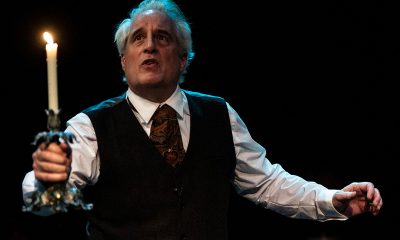Theater
Synetic switches gears
Radially different new show is tour de force for Mills


Alex Mills plays Jerry in Synetic’s ‘A Tale of Two Cities.’ (Photo by Koko Lanham, courtesy Synetic)
A Tale of Two Cities
Through June 21
Synetic Theater
1800 S. Bell Street, Arlington, Va.
Tickets: $20-60
866-811-4111
“A Tale of Two Cities” isn’t the usual Synetic Theater production. Unlike the daring movement-based company’s other works (heavy on innovative choreography often performed in silence) this campy comedy has many, many words almost all exclusively spoken by out actor Alex Mills.
Mills plays Jerry, a preternaturally perky drag queen and sometime wigmaker. It’s the day of his opening night at Sally’s the local drag palace, and while attending to myriad pre-show details, he finds a bawling baby (Vato Tsikurishvili) on his doorstep. After varied attempts to quiet the baby including allowing him to teethe on a Bic lighter, Jerry decides to act out MGM’s 1935 star-studded version of Charles Dickens’ “A Tale of Two Cities” in its entirety. And of course, Jerry will play all the parts.
Though not essential, it helps to know the novel or the movie. Set against the French Revolution, dissolute attorney Sydney Carton (played to perfection in the film by handsome Ronald Coleman) finds redemption in giving his life to save young nobleman Charles Darnay from the guillotine. Mills as Jerry plays both men. He also takes on the role of Darnay’s young wife Lucy Manet; Lucy’s staunch companion, Miss Pross; Lucy’s broken father; the understandably vengeful Madame Defarge; and the evil and effete Marquis St. Evremonde, among others.
Improvisation is the thing. Jerry uses sewing forms, wig heads and other items from his cluttered apartment to bring the story to life. Increasingly he becomes so caught up in Dickens’ tale that he rouses the baby from slumber to let him know what happens next. Moving through the chapters, Jerry goes through a transformation. He begins as a gay man in street drag (red Capri pants and a flowery top). From there he entertainingly strips naked, bathes, shaves and slowly metamorphoses into his complete drag persona. For a large part of the show, he’s wearing stage makeup, a wig cap and padded foundation garments before ultimately emerging in full, glittery drag.
Originally written and performed by Everett Quinton in 1988, “A Tale of Two Cities” was created in large part to showcase the versatility and camp virtuosity of its lead actor. Quinton cut his theatrical teeth as part of Charles Ludlam’s Ridiculous Theatrical Company, the famed New York troupe known for blending classical literature and downtown camp. Quinton and Ludlam, who died from AIDS in 1987, had been lovers.
As Jerry, Mills is peppy, theatrical and sexy. His other characters are well-defined enough, but in some cases they could certainly be plumbed for more laughs. For instance, his Pross might be imbued with more elements of the widely impersonated Edna May Oliver who so memorably played the role on screen; and while his staccato Defarge is funny, it ultimately proves a little too one note.
In the part of baby, Tsikurishvili brings Jerry’s thumb-sucking sidekick to life with a marathon of mugging and double takes. He’s glued to the couch throughout most of the show, an adult-sized head with doll hands, reacting to the twists and turns of a long and complicated bedtime story.
Out director Serge Seiden leads an able design team in enlivening Jerry’s long retelling of Dickens’ classic with inventive use of Jerry’ tiny flat, evocative lighting and various sounds of the mob and rousing music. And in the end, two surprisingly comparable characters come together: Fiction’s Carton, the redeemed martyr; and Jerry, a drag queen who is finding his way in a tough world.
Theater
Astounding ‘LIZZIE’ builds on legendary axe murder tale
Rock musical twist addresses abuse, oppression, queer identity

‘LIZZIE’
Through Nov. 30
Keegan Theatre
1742 Church St., N.W.
$54-$65
Keegantheatre.com
Lizzie Borden put Fall River, Mass., on the map. When the 32-year-old, seemingly respectable woman was charged with the axe murder of her father Andrew and stepmother Abby in the summer of 1892, it sent shock waves across the community and far beyond.
In time, the gruesome tale would weave its way into the annals of American crime lore, always remembered through that popular nursery rhyme “Lizzie Borden took an axe, gave her father 40 whacks…” Well, you know the rest.
The astoundingly terrific “LIZZIE” (now playing at Keegan Theatre, a short walk from Dupont Circle Metro) builds on the legend. The rock musical with book by Tim Maner, music by Steven Cheslik-deMeyer and Alan Stevens Hewitt, and lyrics by Cheslik-deMeyer and Maner, follows the days leading up to the grisly murders (unseen offstage) through Lizzie’s acquittal, bringing to the fore matters of abuse, oppression, and queer identity.
Shrewdly staged and choreographed by Jennifer J. Hopkins, the show begins with a haunting version of “Forty Whacks (Prologue),” featuring the talented cast of four women who can sing, act, move, and deliver the occasional laugh-out-loud line.
Clearly, frustrated Lizzie (powerfully played by Caroline Graham) and dominant older sister Emma (Sydne Lyon), both unmarried and still at home, are angsty and deeply unhappy. They resent their father for a litany of reasons including his extreme Yankee frugality. While one of the richest men in Fall River, he chooses to live on a sad street and go without indoor plumbing rather than set up housekeeping in posh digs across town. But it’s when they see Andrew’s great fortune slipping away to their stepmother that their fury reaches new heights.
Much of “LIZZIE” takes place at the scene of the crime, the Borden residence – cleverly suggested by scenic designer Josh Sticklin with some clapboard siding, stairways, a bit of period wallpaper and a purposely incongruous, large Borden family coat of arms.
Lighting designer Sage Green, convincingly and evocatively, summons at turns a bona fide rock concert experience, dimly lit parlor, or an intimate setting in a small yard.
And costume designer Logan Benson savvily adds to the atmosphere. Lizzie’s somber dresses with their accurate to the era leg-of-mutton sleeves give way to something altogether glitzier and more revealing after the murders.
There is dialogue, but the Riot Grrrl-inspired work is mostly sung through with punk rock anthems, ballads, and character driven songs. Whether spoken or sung, “LIZZIE” makes no bones about the title character’s guilt while introducing varying levels of collusion among the other women.
A knowing wry smirk from the house maid Bridget (Brigid Wallace Harper) says a lot about the family dynamic (“there’s a lock on every door / In every room a prisoner of a long, silent war”) as well as what went down that summer morning at the Borden house.
Lizzie’s secret girlfriend Alice (golden throated Savannah Blackwell) who conveniently lives next door, is besotted and watches her every move. Just after the murders, she saw Lizzie burn a dress in the yard.
The hard driving score is played by a passionate half-dozen strong band led by Marika Countouris. Sometimes, the instruments overpower the amplified singers and a lyric or two is lost, but that’s not so unusual with rock musicals.
At 90 minutes with a leisurely intermission (well-earned by the band and cast, especially Graham as Lizzie who’s onstage throughout, often incorporating frenetic movement and strenuous air guitar into her many songs), the first half explores feelings of entrapment and the second liberation.
Lizzie goes to trial. Despite a shaky alibi, the defendant seems to be winning over the jury. Looks like she might get that grand house on the hill after all.
The Borden story has been shared in varied ways including innumerable books and documentaries, Jack Beeson’s opera “Lizzie Borden” (1965), Agnes de Mille’s ballet “Fall River Legend” (1954), and the memorable 1975 TV movie starring Elizabeth Montgomery (best known as the perky reluctant witch Samantha Stevens on TV’s sitcom “Bewitched”) playing against type.
Today, the legend endures with “LIZZIE” at Keegan.
Theater
Reggie White explores the many definitions of home in ‘Fremont Ave.’
‘Music and humor set against the rhythm of a cutthroat game of spades’

‘Fremont Ave.’
Through Nov. 23
Arena Stage
1101 Sixth St., S.W.
Tickets start at $49
Arenastage.org
For Reggie D. White, growing up Black and queer in the late 1980s and early ‘90s, there wasn’t a lot of vocabulary for his experience outside of the AIDS crisis. Despite being surrounded by family who loved him, White felt isolated in his own home; there was a sort of membrane that prevented him from being present.
With his new play “Fremont Ave.,” now running at Arena Stage, White has written a work about home and the many definitions of that idea specifically relating to three generations of Black men.
Set in a house on a street in a Southern California suburb (similar to where White grew up), “Fremont Ave.” explores the ways a lack of belonging can be passed down generationally. The first act is boy meets girl and creating a home; and the second watches the next generation struggling to achieve something different.
“The third act’s storyline is deeply queer,” White explains. “Boyfriends Joseph and Damon have been together for years yet can’t figure out what it means to make a home. We don’t totally see the relationship solved, but there’s a glimmer of hope that it just might make it.”
The playwright notes, it’s not all about familial angst and alienation: “Much of the play is music and humor set against the rhythm of a cutthroat game of spades.”
Playwright, actor, and educator, White “does all the things.” Currently, he holds the title of Arena’s senior director of artistic strategy & impact, a role focused on artistic vision and growth. Superbly energetic, White splits his time between Arena and his prized rent-stabilized residence in Brooklyn’s desirable Park Slope neighborhood. He’s already told his landlord that he’s never leaving.
At seven, he came close to landing the part of young Simba in the pre-Broadway “Lion King.” Soured by the near miss, White turned his attention to sports and studies. In his freshman year at college in the Bay Area, he took a musical theater class for the heck of it, and soon gave up law school ambitions to focus on show biz. He went on to appear in Matthew López’s Broadway success “The Inheritance” until the pandemic hit.
Winning the Colman Domingo Award in 2021 gave White the flexibility to write “Fremont Ave.” (The award is given to a Black male or male-identifying theater artist and includes a cash stipend and development opportunities.)
“It can be scary to make a career in the arts. I ran from it for a long time. Then one morning I just woke up very grateful for the accumulation of accidental circumstances that landed me in this moment.”
WASHINGTON BLADE: Is queerness your secret to success?
REGGIE D. WHITE: I’m not saying that being queer is my mutant super power, but I do think there is an element of living my life on the margins trying to find a place for myself that I’ve been able to observe relationships and how people engage and interact with each other that gives me a real objective eye on how to render a world that I didn’t live in.
BLADE: What’s queer about your work?
WHITE: There’s this thing that James Baldwin said a lot, it’s about being on the outside of an experience, being able to observe more astutely. With “Fremont Ave.” it felt important to me that the actor leading us through is played by a queer actor. I wanted that authenticity and that experience of having felt isolation.
It’s unique that the central man in each story, the grandfather, stepson, and grandson are played by the same queer actor Bradley Gibson, that amazing TV star with the big muscles.
It’s also interesting to watch a single body traverse over generations in the same house (altered over time by appliance and art updates).
BLADE: Premiering your play as part of Arena’s 75th anniversary season must be a thrill.
WHITE: Sometimes I ask myself, how is this happening? And I didn’t even have to sleep with anybody. But seriously, I’m lucky. Arena excels at taking great care of world premieres, and the production’s director Lili-Anne Brown has a visceral sense of how to create community and life on stage.
BLADE: What else is unique about “Fremont Ave.”?
WHITE: Men aren’t a particularly emotionally literate species, so there haven’t been a lot of plays exploring the emotional condition of men and what it means to learn to love.
For men, love looks like silence. I wanted to explore what it looks like when there’s a deep curiosity about the people we’ve known and loved.
BLADE: Was risk involved?
WHITE: I wrote a deeply personal play. That’s scary. So, to see everyone involved invest their own love into what’s my play, that’s incredible, and a great confirmation of “specificity is the key to universality.” People seeing themselves in the characters has been both beautiful and surprising.
Theater
Set designer August Henney puts new spin on Mary Shelley’s life
‘So Late Into the Night’ an ideal fall show at Rorschach

‘So Late Into the Night’
Through Nov. 2
Rorschach Theatre
The Stacks @ Buzzard Point
101 V St., S.W.
Spooky Action Theater
Washington, D.C.
Tickets start at $74
Rorshachtheatre.com
We’ve all been to that scary party or two. But ordinarily, it’s not by choice.
But with playwright Shawn Northrip’s So Late Into the Night, the spookiness is planned, executed, and fun. Northrip lays out the story of novelist Mary Wollstonecraft Shelley, famed author of the gothic masterpiece Frankenstein, and in gathering her Romantic poet friends and lovers, investigates their afterlife.
What’s more, the new play, which also features a rock séance, is performed in the Stacks at D.C.’s Buzzard Point neighborhood, a unique neighborhood positioned where the Potomac and Anacostia Rivers meet, just south of Audi Field.
At the Stacks, Rorschach is activating a high-ceilinged corner retail that serves as the company’s fall home base. Inside the cavernous space, the production’s set designer August Henney is putting a new spin on Newstead Abbey, the grand home of Lord Byron, a friend of Shelley. Included in the new look are a Victorian dining table (33 by 12 feet), grand drapes, and modern rock and roll posters. Audience members can sit at the table or the risers on the perimeter.
Henney, who identifies as a trans gay man, is a Bay Area transplant who arrived in D.C. three years ago to study scenic design at the University of Maryland. The experience has been transformational.
WASHINGTON BLADE: How do you pursue concept before realizing a set?
AUGUST HENNEY: At first, I go through the script and take out words that spark inspiration. I’m very much a words person – I find words and then relatable images. Next, I create a collage and present it to the director.
BLADE: Along the way, does the director exert control?
HENNEY: Oh yes. It’s hopefully conversation, but they have the final say about everything. If it’s very important to me or I think it’s very important to the show, I’ll fight for it.
BLADE: When the show kicks off does your vision typically come to fruition.
HENNEY: That depends entirely on the technical director. I do the drafting and present it to the tech director. Lays out how to do that. Like an engineer and architect. This is how I want the façade to look but I don’t care so much about the insides. Comes down to what we can and can’t do. Usually comes down to cost.
BLADE: How much was learned in life and now much at school?
HENNEY: At school, I came in not knowing much. UMD cleverly matched us up with a cohort who has different skills from you. They do that well. So, there were endless hours in the hallways of the grad school where we’d build models until 3 a.m. working and blasting music. I also learned from my father who is adept at wood working, and jobs in prop shops.
BLADE: How was your coming out as a trans gay man?
Henney: Well grad school really helped with that. I believe the universe puts people in places. And with UMD, it put me in the right place. At undergrad, I got another degree in human physiology and thought I wanted to be a doctor for a second. My path would have been very different.
Scenic design placed me in range of the right people who helped me realize things about myself that I didn’t have to keep hiding. Theater is such an inclusive community already and I feel safe here while the world is so unsafe.
BLADE: This morning, I heard the administration was blaming the government shutdown on trans people. Does that kind of madness get you angry?
HENNEY: Angry, frustrated, and despondent. I get through the days by focusing on the good bits, and the people who make me feel like myself. That’s all you can really hope for in a world that’s falling apart.
BLADE: Yet, the show goes on.
HENNEY: Oh yes, and So Late Into the Night is a wonderful show. It pairs with some of the best things in the world like spooky ghost stories and dramatic rock music in autumn, the perfect season. It’s a show where audience members can feasibly be seated next to Mary Shelley and friends at a big dining table on Halloween night. How great is that?
-

 District of Columbia3 days ago
District of Columbia3 days ago‘Sandwich guy’ not guilty in assault case
-

 Sports3 days ago
Sports3 days agoGay speedskater racing toward a more inclusive future in sports
-

 New Jersey4 days ago
New Jersey4 days agoBlue wave hits Northeast: Sherrill and Mamdani lead Democratic comeback
-

 District of Columbia4 days ago
District of Columbia4 days agoTrial begins for man charged with throwing sandwich at federal agent


















